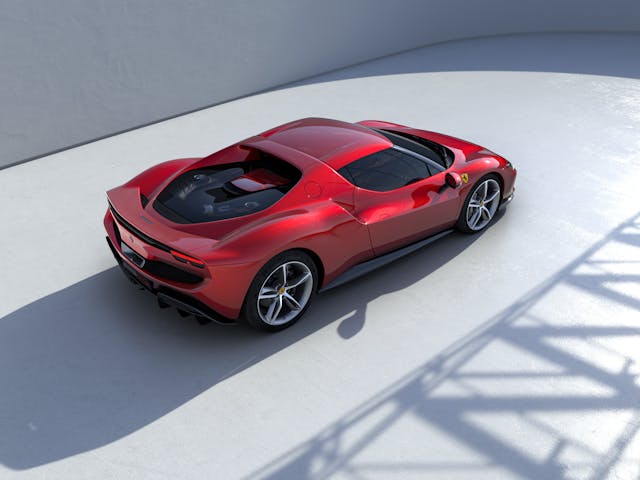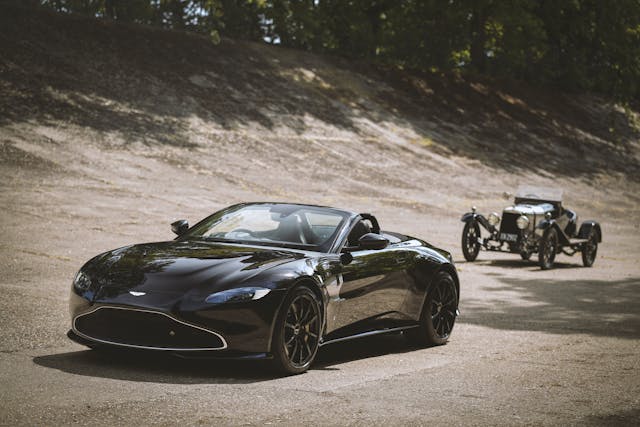Media | Articles
Civic hatch keeps manual, first V-6 Ferrari since the Dino, last Lister Costin up for grabs
Welcome to The Manifold, our fresh daily digest of news and what’s happening in the car world.
Honda’s 2022 Civic hatch stuffs fun and function into new skin—with a manual transmission
Intake: The next variant of Honda’s 11th-generation Civic, the five-door hatch, broke cover today. Four trims will be offered, including the LX, Sport, EX-L, and Sport Touring, in ascending order of equipment and cost. The new composite rear hatch—star of the show here—has been widened by 1.6 inches to improve loading and unloading. Two engines will be offered: a 158-hp, 2.0-liter naturally-aspirated four (LX and Sport), and a 180-hp, 1.5-liter turbocharged four (EX-L and Sport Touring). The Sport and Sport Touring models can be had with a six-speed manual for added engagement. For the first time, the Civic hatch will be built in the United States at Honda’s plant in Greensburg, Indiana. Honda has yet to release any pricing information for the 2022 Civic hatch.
Exhaust: While it lacks the unabashed hatchback profile of a Volkswagen Golf, the five-door Civic is a welcome addition to the playing field of honest, functional cars seasoned with a dash of fun. We’re disappointed that, like the Civic Sedan, you can’t have the Sport trim with the 1.5-liter turbocharged engine. And, to get the turbo engine and the manual, you’ll have to march all the way up to the range-topping Sport Touring model. Still, we’re glad to see Honda chose to offer a manual transmission at all with this 11th-gen Civic.
Ferrari’s 296 GTB takes the twin-turbo, V-6 hybrid fight to Maserati, McLaren

Intake: The first six-cylinder Ferrari road car since the final Dino 246 GTS in 1974 has finally broken cover—and no, it won’t bear the Dino name. Dubbed 296 GTB, this rear-mid-engine coupe wears sheetmetal that borrows heavily from the SF90’s design language. Between its hips sits a 2992-cc, 120-degree V-6 with two single-scroll IHI turbos sitting between its cylinder banks, capable of boosting output to 653 hp … and that’s before the plug-in hybrid system has its 165-hp say. Total output is 818 hp at 8000 rpm, and 546 lb-ft of torque at 6250.
Exhaust: Welcome to the twin-turbo, hybrid V-6 supercar wars. The 296 GTB takes direct aim at Maserati’s slinky MC20, reigniting a historic rivalry now that Stellantis-owned Maserati is moving away from Ferrari power. The McLaren Artura is another contender in this battle of intricately engineered six-cylinder powertrains.
Marketplace
Buy and sell classics with confidence
This 1959 Lister Costin is the last of the line

Intake: The final Lister Costin ever built is for sale at British dealer Bell Sport & Classic. The Costin followed the famous Lister “Knobbly” and featured more streamlined bodywork by renowned aero-expert Frank Costin. Only 14 cars were made and this example has led a fascinating international existence. Upon its completion in 1959 it was shipped from the factory to the U.S. without an engine, as was common practice at the time. It spent almost 30 years stateside, most likely with a Chevrolet V-8 under its hood, but was never raced, eventually returning to Britain for a new lease of life. A 3.8-liter Jaguar racing motor was installed and the chassis’ authenticity verified before the car began a new racing career, with the highlight being victory in the 2019 Stirling Moss Trophy, the world’s foremost race series for late-1950s sports cars.
Exhaust: After lapping the field in the final race at Portimão, Portugal the car was dubbed “the fastest Lister in Europe.” With this provenance it will, no doubt, sell pretty quickly as well. Asking price is £950,000, or $1.32M.
Three Q-built Aston Martins commemorate 100 years of the “A3”

Intake: A century ago, Aston Martin chassis #3 was wheeled out of the company’s workshop in London’s Kensington, and the British sports car maker is marking the occasion by building three special Vantage Roadsters. “A3” was fitted with an 11-hp 1.5-liter four-cylinder engine which enabled it to lap Brooklands at 84.5 mph; 100 years of progress sees the Vantage Roadster’s twin-turbo V-8 produce 510 hp and give it a top speed of 190 mph. The trio of special editions built by Aston’s Q division each have a distinct, aluminum-shrouded black grille and a heritage badge. The front fender panels have saddle leather straps inspired by the 1921 car with hand-polished panels by prewar Aston Martin specialists Ecurie Bertelli. Other features include bronze brake calipers and 20-inch forged gloss black wheels. The cabin is trimmed in obsidian black and chestnut tan leather with brass switchgear.
Exhaust: Having only just released the Vantage F1 to celebrate its return to top-flight motorsports Aston Martin has found an excuse to produce yet another run of limited edition models. What’s next—a DBX one-year anniversary edition?
Infiniti’s three-row 2022 QX60 hides a new interior under its stylish skin

Intake: Wearing handsome new sheetmetal and snazzy LEDs, Infiniti’s best-selling vehicle receives an equally thorough redesign inside. Highlights include a standard 12.3-inch touchscreen mounted atop the dash, an available 12.3-inch digital instrument cluster, and an optional 10.8-inch heads-up display. Though the plastic steering wheel buttons look a bit underwhelming, the rest of the 2022 QX60’s cabin is clearly differentiated from that of the Pathfinder, with which it shares a platform: haptic climate controls, elegant contours, and stitched leather everywhere. Outside, the two-tone roof is an appropriately modern touch.
Exhaust: When we drove the QX55, the QX50’s chop-top, two-row sibling, we were impressed by its trendy styling but left disappointed with the hit-or-miss interior—specifically, the dated split-screen infotainment. The QX60 finally looks like a cohesively-executed product. Promising.






